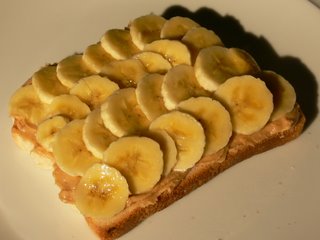 On hearing yet more government waffle about obesity (surely a delicious, cinnamon sugar-dusted waffle) on the radio yesterday morning, I felt moved to action. Especially when Gordon Brown announced that access to the NHS should be rationed for the fat. This seems somewhat hypocritical. Gordon Brown’s own flabby udders are usually concealed by a well-cut suit, but do spare a moment to compare his wobbling great jowls with those of the undeniably fat Vegas-era Elvis, who has been much on my mind recently, it being his birthday yesterday. (Elvis is the one a bit lower down on the right, in case there was any confusion). I have been kind here. This was not the least flattering photo of Gordon I could find.
On hearing yet more government waffle about obesity (surely a delicious, cinnamon sugar-dusted waffle) on the radio yesterday morning, I felt moved to action. Especially when Gordon Brown announced that access to the NHS should be rationed for the fat. This seems somewhat hypocritical. Gordon Brown’s own flabby udders are usually concealed by a well-cut suit, but do spare a moment to compare his wobbling great jowls with those of the undeniably fat Vegas-era Elvis, who has been much on my mind recently, it being his birthday yesterday. (Elvis is the one a bit lower down on the right, in case there was any confusion). I have been kind here. This was not the least flattering photo of Gordon I could find.
 The obese pay as much National Insurance as you or I do, and conditional access to a service that we all pay for is a truly alarming idea – my guess is that Gordon’s trying to make sure the NHS reaches its targets by ensuring it has no patients at all. Only last month, the House of Lords, which surely has better things to do with its time, had a debate on restricting the sale of thick-sliced bread so that our packed lunches are less fattening. What better way, I thought, to stick two fingers up at the lot of the buggers, than to use some thick-sliced bread to make one of Elvis Presley’s favourite, most deadly sandwiches – and to encourage you to too?
The obese pay as much National Insurance as you or I do, and conditional access to a service that we all pay for is a truly alarming idea – my guess is that Gordon’s trying to make sure the NHS reaches its targets by ensuring it has no patients at all. Only last month, the House of Lords, which surely has better things to do with its time, had a debate on restricting the sale of thick-sliced bread so that our packed lunches are less fattening. What better way, I thought, to stick two fingers up at the lot of the buggers, than to use some thick-sliced bread to make one of Elvis Presley’s favourite, most deadly sandwiches – and to encourage you to too?
Elvis was a man of huge appetites. He was particularly big (if you’ll pardon the pun) on very large, very calorific sandwiches involving peanut butter. Legend has it that when visiting Denver, he ordered 22 Fool’s Gold sandwiches from the Colorado Mine Company restaurant (now closed) to be delivered to his aeroplane for the trip home. These sandwiches cost $49.50 each back in 1976. Each one was made from a single French loaf, hollowed out and rubbed generously with margarine. The greasy loaf was coated with peanut butter, baked until the bread was crisp and the peanut butter runny, then adorned with a pound of crisp bacon and a whole jar of grape jelly.
A single Fool’s Gold sandwich rocks up at more than 9000 calories.
I decided not to recreate the Fool’s Gold sandwich, because it seemed a sure-fire route to an untimely death on the toilet. Back at Graceland, however, a favourite snack (snack!) was the fried peanut butter and banana sandwich, which comes in at a relatively modest 750 calories. I used the canonical recipe, which uses an unholy amount of butter, as described by Mary Jenkins Langston, Elvis’s own cook. Now, I am a fan of peanut butter, of white bread, of bananas and of butter. But I have to tell you that I wasn’t able to eat a whole one, and that as I write this I am feeling distinctly unwell and am clutching at a glass of Alka Seltzer.
 This is largely because of the huge amount of butter that goes into this sandwich – two US sticks of the stuff (that’s eight ounces) for every three sandwiches. As Mary herself said, Elvis was very, very keen on using other substances as a mere vehicle for gallons and gallons of good old fat:
This is largely because of the huge amount of butter that goes into this sandwich – two US sticks of the stuff (that’s eight ounces) for every three sandwiches. As Mary herself said, Elvis was very, very keen on using other substances as a mere vehicle for gallons and gallons of good old fat:
”For breakfast, he’d have homemade biscuits fried in butter, sausage patties, four scrambled eggs and sometimes fried bacon,” she said. “I’d bring the tray up to his room, he’d say, ‘This is good, Mary.’ He’d have butter running down his arms.”
Of the sandwich, she said:
”It’d be just floating in butter. You’d turn it and turn it and turn it until all the butter was soaked up; that’s when he liked it.”
It wasn’t drugs that killed Elvis. It was Mary’s cooking.
To make one sandwich (do not, under any circumstances, attempt to eat the whole thing yourself, because you’ll make yourself sick) you’ll need:
1 large banana
2 slices white bread
Peanut butter
2½ oz butter
 Toast the bread lightly, and spread both slices thickly (I know, I know, but Mary says ‘thickly’, so thickly is how I am spreading) with peanut butter. Slice the banana into coins and layer them on top of one peanut-slathered slice of bread, then put the other on top, pressing so the whole thing sticks together.
Toast the bread lightly, and spread both slices thickly (I know, I know, but Mary says ‘thickly’, so thickly is how I am spreading) with peanut butter. Slice the banana into coins and layer them on top of one peanut-slathered slice of bread, then put the other on top, pressing so the whole thing sticks together.
Melt the butter in a non-stick frying pan or cast-iron skillet and heat it until it foams. Slide the sandwich in and fry it, turning frequently (important, this turning, or else you will end up with a hunk-a hunk-a burning sandwich) for about five minutes, until the centre is heated through and the lake of butter absorbed.
Eat with a knife and fork, a glass of antacid, and intimations of mortality.
This is a rich chocolate pudding, which makes its own sauce when cooked and rises like a chocolate sponge island in a syrupy chocolate sea. Your mother probably made chocolate puddle pudding. I’ve been asking around, and everybody’s mother seems to have had a similar recipe – and what sensible mothers they were, because this is rich and delicious, malevolently chocolatey and so quick and easy that my cats could make it (given opposable thumbs, the ability to read recipes and access to some weighing scales, an oven, bowls and…you get the idea). To serve six, you’ll need:


